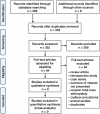Metal-backed versus all-polyethylene tibial components in primary total knee arthroplasty
- PMID: 21895503
- PMCID: PMC3242956
- DOI: 10.3109/17453674.2011.618913
Metal-backed versus all-polyethylene tibial components in primary total knee arthroplasty
Abstract
Background and purpose: The choice of either all-polyethylene (AP) tibial components or metal-backed (MB) tibial components in total knee arthroplasty (TKA) remains controversial. We therefore performed a meta-analysis and systematic review of randomized controlled trials that have evaluated MB and AP tibial components in primary TKA.
Methods: The search strategy included a computerized literature search (Medline, EMBASE, Scopus, and the Cochrane Central Register of Controlled Trials) and a manual search of major orthopedic journals. A meta-analysis and systematic review of randomized or quasi-randomized trials that compared the performance of tibial components in primary TKA was performed using a fixed or random effects model. We assessed the methodological quality of studies using Detsky quality scale.
Results: 9 randomized controlled trials (RCTs) published between 2000 and 2009 met the inclusion quality standards for the systematic review. The mean standardized Detsky score was 14 (SD 3). We found that the frequency of radiolucent lines in the MB group was significantly higher than that in the AP group. There were no statistically significant differences between the MB and AP tibial components regarding component positioning, knee score, knee range of motion, quality of life, and postoperative complications.
Interpretation: Based on evidence obtained from this study, the AP tibial component was comparable with or better than the MB tibial component in TKA. However, high-quality RCTs are required to validate the results.
Figures
Similar articles
-
All-polyethylene versus metal-backed tibial components in total knee arthroplasty: a meta-analysis of randomized controlled trials.Eur J Orthop Surg Traumatol. 2023 Dec;33(8):3611-3622. doi: 10.1007/s00590-023-03594-y. Epub 2023 May 30. Eur J Orthop Surg Traumatol. 2023. PMID: 37249643 Free PMC article. Review.
-
Metal or Modularity: Why Do Metal-Backed Tibias Have Inferior Outcomes to All-Polyethylene Tibial Components in Patients With Osteoarthritis.J Arthroplasty. 2017 Mar;32(3):836-842. doi: 10.1016/j.arth.2016.09.036. Epub 2016 Oct 5. J Arthroplasty. 2017. PMID: 27816367
-
Metal-Backed Tibial Components Do Not Reduce Risk of Early Aseptic Loosening in Unicompartmental Knee Arthroplasty: A Systematic Review and Meta-Analysis.J Knee Surg. 2020 Feb;33(2):180-189. doi: 10.1055/s-0038-1677506. Epub 2019 Jan 16. J Knee Surg. 2020. PMID: 30650439
-
All-polyethylene vs. metal-backed tibial component in total knee arthroplasty-a randomized RSA study comparing early fixation of horizontally and completely cemented tibial components: part 2. Completely cemented components: MB not superior to AP components.Acta Orthop. 2005 Dec;76(6):778-84. doi: 10.1080/17453670510045363. Acta Orthop. 2005. PMID: 16470429 Clinical Trial.
-
Revision of Unicompartmental to Total Knee Arthroplasty: Does the Unicompartmental Implant (Metal-Backed vs All-Polyethylene) Impact the Total Knee Arthroplasty?J Arthroplasty. 2018 Jul;33(7):2203-2209. doi: 10.1016/j.arth.2018.02.003. Epub 2018 Feb 12. J Arthroplasty. 2018. PMID: 29525342
Cited by
-
All-polyethylene tibia components have the same functional outcomes and survival, and are more cost-effective than metal-backed components in patients 70 years and older undergoing total knee arthroplasty : propensity match study with a minimum five-year follow-up.Bone Jt Open. 2022 Dec;3(12):969-976. doi: 10.1302/2633-1462.312.BJO-2022-0063.R1. Bone Jt Open. 2022. PMID: 36519385 Free PMC article.
-
Minimum twelve-year follow-up of fixed- vs mobile-bearing total knee arthroplasty: Double blinded randomized trial.J Clin Orthop Trauma. 2020 Jan-Feb;11(1):154-159. doi: 10.1016/j.jcot.2019.03.019. Epub 2019 Mar 29. J Clin Orthop Trauma. 2020. PMID: 32002005 Free PMC article.
-
All-polyethylene tibial components in distal femur limb-salvage surgery: a finite element analysis based on promising clinical outcomes.J Orthop Surg Res. 2017 Apr 4;12(1):57. doi: 10.1186/s13018-017-0555-6. J Orthop Surg Res. 2017. PMID: 28376828 Free PMC article.
-
Monoblock all-polyethylene tibial components have a lower risk of early revision than metal-backed modular components.Acta Orthop. 2013 Dec;84(6):530-6. doi: 10.3109/17453674.2013.862459. Epub 2013 Nov 18. Acta Orthop. 2013. PMID: 24237424 Free PMC article.
-
No changes in bone mineral density following total knee arthroplasty using an all-polyethylene tibial component.Eur J Orthop Surg Traumatol. 2024 Feb;34(2):1057-1064. doi: 10.1007/s00590-023-03762-0. Epub 2023 Nov 1. Eur J Orthop Surg Traumatol. 2024. PMID: 37907769
References
-
- Adalberth G, Nilsson KG, Byström S, Kolstad K, Milbrink J. Low-conforming all-polyethylene tibial component not inferior to metal-backed component in cemented total knee arthroplasty: prospective, randomized radiostereometric analysis study of the AGC total knee prosthesis. J Arthroplasty. 2000;15(6):783–92. - PubMed
-
- Adalberth G, Nilsson KG, Byström S, Kolstad K, Milbrink J. All-polyethylene versus metal-backed and stemmed tibial components in cemented total knee arthroplasty. A prospective, randomised RSA study. J Bone Joint Surg (Br) 2001;83(6):825–31. - PubMed
-
- Apel DM, Tozzi JM, Dorr LD. Clinical comparison of all-polyethylene and metal-backed tibial components in total knee arthroplasty. Clin Orthop. 1991;273:243–52. - PubMed
-
- Bach CM, Mayr E, Liebensteiner M, Gstöttner M, Nogler M, Thaler M. Correlation between radiographic assessment and quality of life after total knee arthroplasty. Knee. 2009;16(3):207–10. - PubMed
-
- Bartel DL, Burstein AH, Santavicca EA, Insall JN. Performance of the tibial component in total knee replacement. J Bone Joint Surg (Am) 1982;64(7):1026–33. - PubMed
Publication types
MeSH terms
Substances
LinkOut - more resources
Full Text Sources
Medical
Miscellaneous



